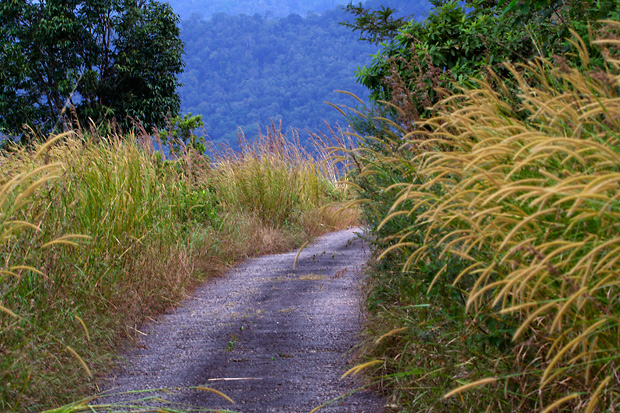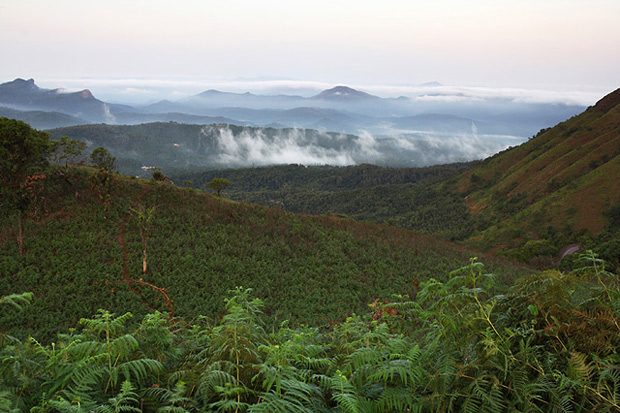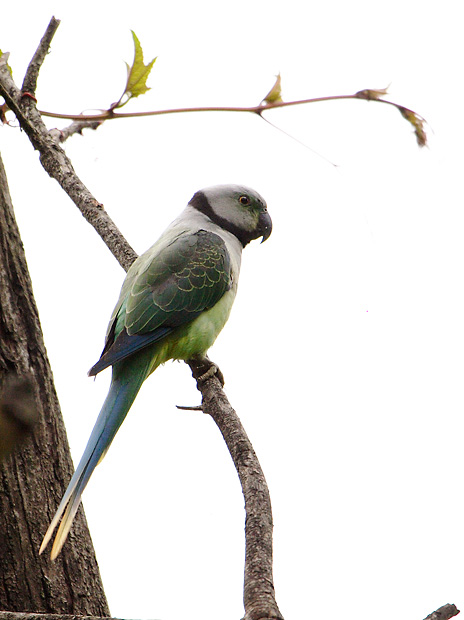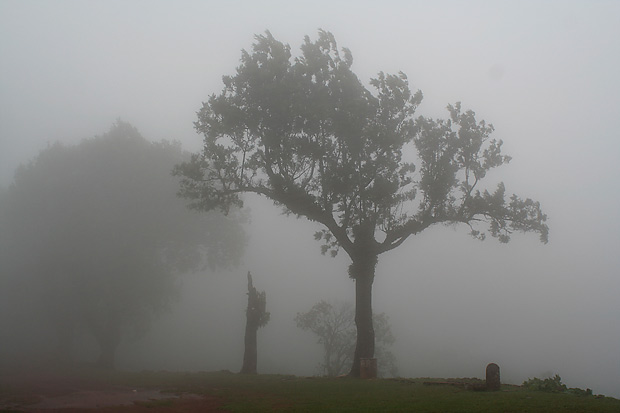A short visit to Chikmagalur
I spent the September busy, if not pretending to be busy. To tell you the truth, all I did was to travel and muse about travel. A trip to Shimla kept me in in a mood for mountains for a long time, when all I did was to let my thoughts linger there. As they often say these days, I needed another holiday to get over the holiday mood.
This time the destination was the hills of Mullayyanagiri bordering the Bhadra Wildlife Sanctuary. It was going to be an inactive holiday – no intensive travel, no exploring, no photography. No activity, that’s all!

A file photo of a road near Mullayyanagiri
We had left Bangalore on a rainy afternoon and arrived at Chikmagalur at 11pm – a little later than we would have liked to. It was still drizzling as we got into the rugged jeep that took us deeper into the hills. We drove on a wet and misty road towards the hills of Mullayyanagiri with no thoughts in the mind but to quickly reach the destination and retire for the day. I would have liked it if we were on this road during the day, when one could see the lush grass on the slopes, and when weather permits, rolling hills or the plains of Chikmagalur. But not to feel bad, we were to spend two days in a coffee estate nestled in the depth of these hills.
With us in the jeep was Prasad, the cheerful driver and the estate manager Cariappa. Cariappa kept to himself first but quickly got talking when Prasad started a conversation.
‘I have been managing the plantations here for 33 years now. There are multiple estates spread in different locations around Chikmagalur…
‘I am from Ammathi at Coorg. I would like to go back to Coorg now but they would not let me..’
‘We always used to spot some or the other wild animals on the way to the estate. There was nothing today, not even a deer or boar..’
We reached the estate exactly at midnight. Having arrived in the dark, I had no clue about the location and setting of the estate. It wasn’t much different next morning either, when I woke up to see a thick fog blocking my views. But with whatever little I could see through the fog once in a while, it did seem like a beautiful place. Occasional holes in the blanket of moving fog revealed me a hill covered with thick tropical vegetation at its base and a silver-oak plantation near its grassy ridge. It seemed like there was a valley far below hidden in the fog that I would never get to see in the days I was to spend there.

A file photo of hills near Mullayyanagiri
Within my views were the coffee plants spread on the slopes, a few buildings within the coffee estate and the dirt roads that crisscrossed the area. A silhouette of tall Silver Oaks stood parallel to each other in the fog. The trees in the estate looked wet, fresh and green, washed by three months of monsoons. The place looked mysteriously beautiful in the foggy weather, but left me in anticipation of seeing the landscape behind the depth of the fog.
Sitting back on my chair in the balcony with a book in my hand that morning, I watched the wind carry the clouds away and bringing in a fresh lot every now and then. The day was just unfolding for me, and also for the birds in the forest. I excitedly watched a barbet land on a tree very close to where I sat. A grey wagtail came closer and landed on the roof before it saw me and flew away. Malabar Parakeets made long distance flights between gaps in the canopy, squeaking loudly in flight. Red Whiskered Bulbuls inspected the nearby bushes, probably in search of worms. I watched them all, drowning cup after cup of hot filter coffee that compensated for the cold mountain breeze, occasionally glancing at my book when the outside world fell silent.

File photo of a Malabar Parakeet in Bhadra Wilderness
On a long walk past the estate later in the day, the magic of the monsoon unfolded in the slopes of the coffee country. I saw along my way, a bell-shaped purple flower with tiny water droplets on its petals that kept it fresh and beautiful. As I bent down to take a closer look, a tiny insect walked out from the heart of the flower, having had a stomach full of nectar. I peeped in closer to see two more of its kins busy feeding. A little later, I found a bee-like insect hovering over small yellow flowers, sucking the juice with ease with its long and sharp suction pipe located on its nose, which allowed it to easily delve deeper into the flower. Big butterflies of all colours hovered on the blooming flowers – one with a greenish wing with a strip of bright white, another with dark wings with a sparkling blue patch and another one bight yellow.
Up on the trees with their barks crowded with lichens, birds fluttered and sang happily. I saw a scarlet minivet that stood out in the greenery with its crimson plumage, a bunch of babblers, a flock of white-eyes and a large number of bulbuls. A hawk cuckoo sat graciously on a branch and inspected its surroundings. On a sharp curve along a steep slope where the trees were spread thinly to keep the coffee in shade, the mid-day symphony of the cicadas amplified into an almost ear-piercing clamour. Streams emerged from the slopes, appearing pristine but probably laden with pesticides from the coffee plantations sprayed before the monsoons. Fog disappeared slowly with progress of the day, revealing smooth grass laden slopes above the treeline.
A let up in the fog reveled the valley of Bhadra later in the day. In the view was thick uninterrupted greenery covered the wide basin of the valley, with hills rising again at the far end. Reflection from the waters of Bhadra Reservoir sparkled brightly near the horizon. Fog played with the scenery like a curtain raising and falling, sometimes letting in just a glimpse of the wide expanse of the vista.

File photo – A foggy day near Mullayyanagiri
Later in the day, I spoke to Aravaind, the estate owner and former forest ranger, about the conservation efforts in Bhadra Wildlife Sanctuary. The reserve makes a good examples of rehabilitating people who once lived in the park and depended partially on the forest for livelihood. When the sanctuary was notified, the villagers in the forest were efficiently rehabilitated and every family was given arable land elsewhere in the district.
‘Some villages were deep in the forest. They had to walk for two hours to get to the nearest shop,’ Aravind told me, ‘so if they want to have some chicken for dinner, it would have been easy to go search for some fowl in the jungle than walk for four long hours.’
I have seen some results of the rehabilitation myself. In places where they had paddy fields before people moved out, you now see a bunch of bisons carelessly feasting on wild grass. Spread across an area of nearly 2,000 km², Bhadra is a tiger reserve with thick tropical forest and a population of more than 30 tigers (according 1997 census. See project tiger website). The trees here are tall and the canopy so thick, once traversing in this forest, I heard bird calls all along the way from the treetop, but never once managing to spot the origin of these sounds.
Spending another day in the foggy but pleasing weather, we drove back to Chikmagalur next day, again in darkness, again wishing that we had driven during the day.